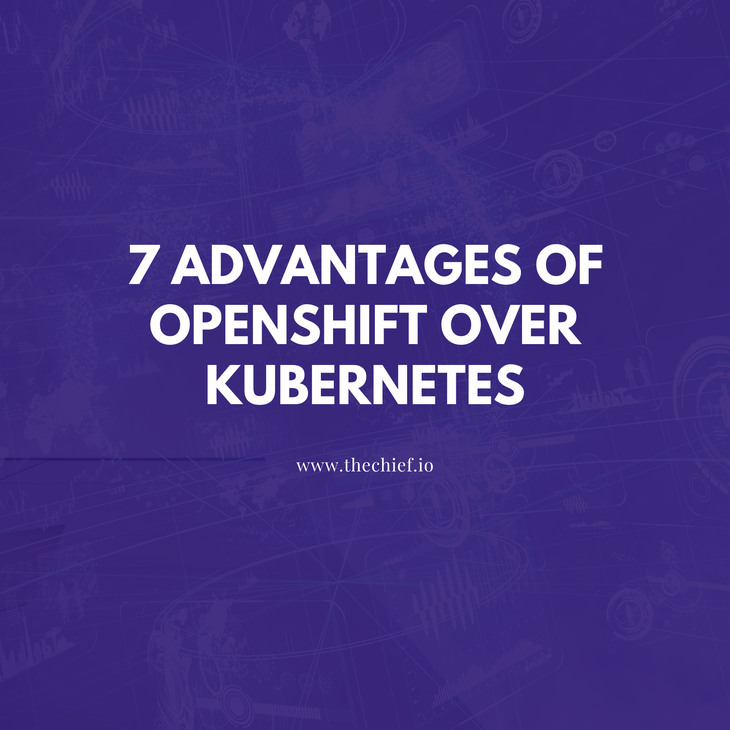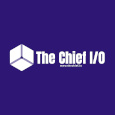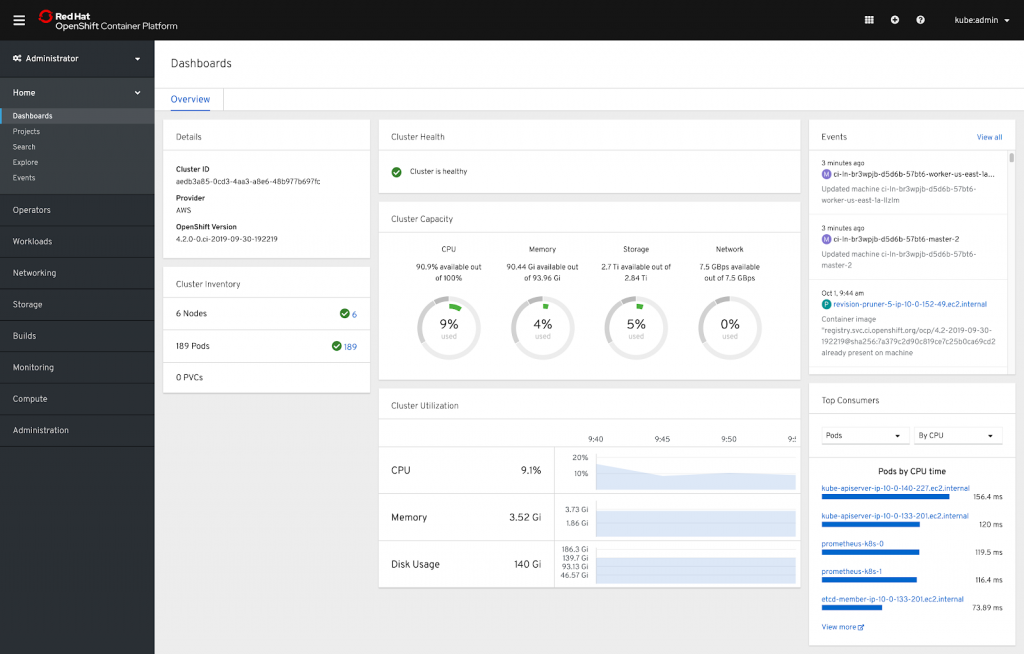7 Advantages Of OpenShift Over Kubernetes

While OpenShift offers consistent security, default automation, and compatibility with all major cloud platforms, Kubernetes will be your go-to containerization platform if you prefer a more technical and fully controlled interface.
It is ideal for developers who want a fast, easy to use, and automated containerization to go for Red Hat’s OpenShift, while developers can adopt Kubernetes if they want a more sophisticated, fully controllable environment.
Again, the decision is all yours. We hope you find value in this post to help you make an informed decision on whether to use OpenShift or Kubernetes.
Containerization - the bundling or encapsulation of an application and its required environment to effectively develop, manage and deploy it across various infrastructures - enables organizations and software teams to build more efficient, agile, and scalable applications. Kubernetes and Openshift are the two most commonly used platforms for this purpose.
While Kubernetes and OpenShift appear similar in the context above, there are some notable differences between the two.
As we defined in "Kubernetes vs OpenShift: This is what you need to know", Kubernetes is an open-source container-as-a-service (CaaS), containerization and orchestration engine which helps developers automate and manage the lifecycle of their services and workloads.
On the other hand, OpenShift is also a container management system offered as a Platform-as-a-Service (Paas) by Red Hat - a multinational cloud and open-source software contributor.
It is powered by what is called an Origin Kubernetes Distribution (OKD). OpenShift is fundamentally built on Kubernetes, Docker, and some other open-source DevOps toolings like Istio.
Simply put, OpenShift is the most popular implementation of Kubernetes’ orchestration platform, but with more features than the native Kubernetes.
Even though it’s based on Kubernetes to a significant extent, OpenShift offers some essential features exclusive to the platform.
We’ll highlight some of the many advantageous differences of OpenShift over Kubernetes.
User Interface
You will want to agree that many developers today will prefer using a visual interface to implement and monitor applications to a command-line interface.
OpenShift offers a default feature-rich graphical interface that allows you to build, deploy, scale, monitor and implement almost every Kubernetes task from a web browser, both as an administrator and developer.
This makes OpenShift simple and easy to use, and time-saving for every developer considering the short learning curve.
Using Kubernetes, the dashboard UI is not deployed by default. You have to deploy and access it by running different commands manually. It will require you to learn some commands before you're able to use them, tiring with the longer learning curve.
Cloud Platform Agnostic
Even though Kubernetes is cloud-agnostic (that is, you can use it with various cloud providers), it isn't as cloud agnostic as OpenShift when compared.
To improve productivity and even protect your interests as a developer, you would want the freedom to migrate your application between different cloud service providers without having to tweak or make changes to your application infrastructure.
Different cloud service providers, AWS, IBM Cloud, Google Cloud Platform, Azure, all offer different Kubernetes managed services whose sets of add-ons, plugins, and usage instructions are specific to each cloud platform. This will require you to get familiar with each cloud service’s managed Kubernetes service to understand how things are done before moving between them.
OpenShift is a “build once and deploys anywhere” container platform that allows you to build, deploy and manage your application with the same web interface across all cloud service platforms.
Automated Workflow
When deploying your application, Red Hat OpenShift offers several automated workflows which are not offered in Kubernetes.
OpenShift supports several programming languages, including Python, Java, PHP, Go, Node.js, and Ruby. It provides pre-created application templates in many of these languages and frameworks to quickly kickstart your application development. In the past, Kubernetes templates are way better than OpenShift templates. It has in its new version. It provided two templates you can use when deploying an app, Kubernetes Helm Charts and OpenShift template. This gives the developer a nicer range of template options.
OpenShift also has an in-built image registry that uses the source-to-image feature that automatically pairs Openshift with DockerHub or Red Hat and allows you to manage container images using image streams easily. You can also use your private image registry with OpenShift.
Kubernetes, on the other hand, does not offer this kind of integrated image management, and it also requires manual configuration for many of its workflows.
In October 2020, Red Hat announced the integration of Ansible Automation with OpenShift. This will improve automation and also amenable enterprises to use Ansible for deployment and management of your application.
Red Hat’s OpenShift does a lot of heavy lifting and automation in the background, making the development, testing, deployment, and production environments of your application much easier with the release of OpenShift 4, an improved version of Openshift.
Continuous Integration/Continuous Delivery (CI/CD) Solution
Coupled with automation at various levels of application, OpenShift offers seamless integration with CI/CD pipeline building tools like Jenkins.
Even though it's not a complete CI/CD solution, OpenShift provides a certified Jenkins container integration that can be used with other tools to set up a complete CI/Cd infrastructure on the OpenShift platform.
Below is an image of a continuous integration and deployment infrastructure built on OpenShift using Jenkins, Gogs, and other tools.
In the case of Kubernetes, it doesn't offer an integrated CI/CD solution. Still, you can use different third-party automated monitoring, testing, and CI/Cd tools and plugins like CircleCI to build a CI/CD pipeline on Kubernetes.
Security
When working on a team of developers with different permissions on an application, there is a need to properly secure each team member's access and permission to the containerization platform to avoid possible attacks.
By default, OpenShift offers the role-based access control (RBAC) that helps ensure that each developer only gets permission to the features they need to avoid the issue of account compromisation.
When you create a project with Openshift, other security rules like IAM and OAuth are all created by default. You only need to add user permissions as required. This makes your application environment easier to set up and saves you time.
On the Kubernetes side, even though it now offers Kubernetes RBAC, you still have to set everything up by yourself, including other security protocols like IAM and OAuth.
OpenShift also has a kind of stricter security compared to Kubernetes. It forbids running a container as root and restricts Docker containers' running as simple images, all to avoid compromise in security.
Recently, Red Hat announced that it had acquired StackRox - a Kubernetes native security platform, to bring more advanced security to OpenShift.
Node Configuration
It is only normal that you have many virtual machines in your cluster, whether virtualized or bare metal. When an application requires an additional virtual machine, Kubernetes’ handling the process is a little complicated and time-consuming.
It requires you to develop scripts to set up self-registration or different cloud automation before creating new VMs then bringing them into the cluster. This process can be a little tiring and time-consuming.
Red Hat’s OpenShift addresses this in a much easier way. You can use the provided Ansible playbooks and installers to bring new virtual machines into the cluster easily.
It also provides auto-scaling, which enables the automatic addition of new virtual machines into the cluster to increase workload.
Operating System Support
This is pretty much not an advantage of Openshift over Kubernetes. In fact, Kubernetes supports all major operating systems, while OpenShift used to be limited to Linux-based containers.
But things changed when Red Hat announced in December 2020 that its OpenShift platform would be supporting Windows-based containers from 2021. This will allow companies to run both Linux and Windows environments as the DevOps industry adopts a hybrid cloud.
Get similar stories in your inbox weekly, for free
Share this story:

The Chief I/O
The team behind this website. We help IT leaders, decision-makers and IT professionals understand topics like Distributed Computing, AIOps & Cloud Native
Latest stories
HIPAA and PCI DSS Hosting for SMBs: How to Choose the Right Provider
HIPAA protects patient data; PCI DSS protects payment data. Many small and mid-sized businesses now …
The Rise of GPUOps: Where Infrastructure Meets Thermodynamics
GPUs used to be a line item. Now they're the heartbeat of modern infrastructure.
Top Bare-Metal Hosting Providers in the USA
In a cloud-first world, certain workloads still require full control over hardware. High-performance computing, latency-sensitive …
Top 8 Cloud GPU Providers for AI and Machine Learning
As AI and machine learning workloads grow in complexity and scale, the need for powerful, …
How ManageEngine Applications Manager Can Help Overcome Challenges In Kubernetes Monitoring
We tested ManageEngine Applications Manager to monitor different Kubernetes clusters. This post shares our review …
AIOps with Site24x7: Maximizing Efficiency at an Affordable Cost
In this post we'll dive deep into integrating AIOps in your business suing Site24x7 to …
A Review of Zoho ManageEngine
Zoho Corp., formerly known as AdventNet Inc., has established itself as a major player in …
Should I learn Java in 2023? A Practical Guide
Java is one of the most widely used programming languages in the world. It has …
The fastest way to ramp up on DevOps
You probably have been thinking of moving to DevOps or learning DevOps as a beginner. …
Why You Need a Blockchain Node Provider
In this article, we briefly cover the concept of blockchain nodes provider and explain why …
Top 5 Virtual desktop Provides in 2022
Here are the top 5 virtual desktop providers who offer a range of benefits such …













